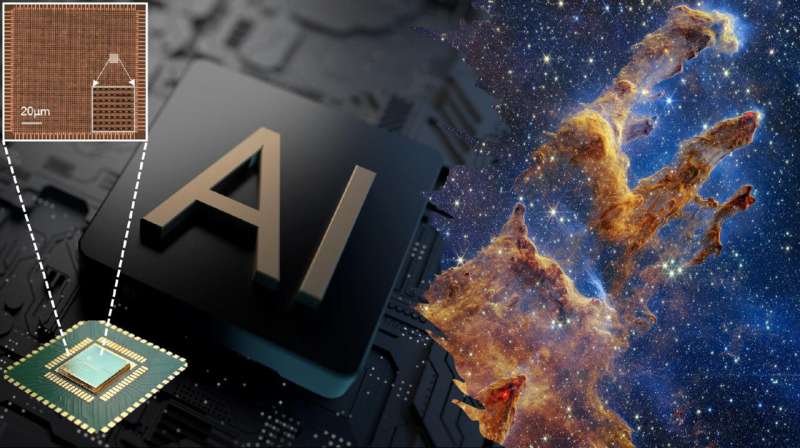This article has been reviewed according to Science X's editorial process and policies. Editors have highlighted the following attributes while ensuring the content's credibility:
fact-checked
peer-reviewed publication
trusted source
proofread
Neuromorphic platform presents significant leap forward in computing efficiency

Researchers at the Indian Institute of Science (IISc) have developed a brain-inspired analog computing platform capable of storing and processing data in an astonishing 16,500 conductance states within a molecular film. Published today in the journal Nature, this breakthrough represents a huge step forward over traditional digital computers in which data storage and processing are limited to just two states.
Such a platform could potentially bring complex AI tasks, like training Large Language Models (LLMs), to personal devices like laptops and smartphones, thus taking us closer to democratizing the development of AI tools. These developments are currently restricted to resource-heavy data centers, due to a lack of energy-efficient hardware. With silicon electronics nearing saturation, designing brain-inspired accelerators that can work alongside silicon chips to deliver faster, more efficient AI is also becoming crucial.
"Neuromorphic computing has had its fair share of unsolved challenges for over a decade," explains Sreetosh Goswami, Assistant Professor at the Centre for Nano Science and Engineering (CeNSE), IISc, who led the research team. "With this discovery, we have almost nailed the perfect system—a rare feat."

The fundamental operation underlying most AI algorithms is quite basic—matrix multiplication, a concept taught in high school math. But in digital computers, these calculations hog a lot of energy. The platform developed by the IISc team drastically cuts down both the time and energy involved, making these calculations a lot faster and easier.
The molecular system at the heart of the platform was designed by Goswami, Visiting Professor at CeNSE. As molecules and ions wiggle and move within a material film, they create countless unique memory states, many of which have been inaccessible so far. Most digital devices are only able to access two states (high and low conductance), without being able to tap into the infinite number of intermediate states possible.
By using precisely timed voltage pulses, the IISc team found a way to effectively trace a much larger number of molecular movements, and map each of these to a distinct electrical signal, forming an extensive "molecular diary" of different states.
"This project brought together the precision of electrical engineering with the creativity of chemistry, letting us control molecular kinetics very precisely inside an electronic circuit powered by nanosecond voltage pulses," explains Goswami.
Tapping into these tiny molecular changes allowed the team to create a highly precise and efficient neuromorphic accelerator, which can store and process data within the same location, similar to the human brain. Such accelerators can be seamlessly integrated with silicon circuits to boost their performance and energy efficiency.
A key challenge that the team faced was characterizing the various conductance states, which proved impossible using existing equipment. The team designed a custom circuit board that could measure voltages as tiny as a millionth of a volt, to pinpoint these individual states with unprecedented accuracy.
The team also turned this scientific discovery into a technological feat. They were able to recreate NASA's iconic "Pillars of Creation" image from the James Webb Space Telescope data—originally created by a supercomputer—using just a tabletop computer. They were also able to do this at a fraction of the time and energy that traditional computers would need.
The team includes several students and research fellows at IISc. Deepak Sharma performed the circuit and system design and electrical characterization, Santi Prasad Rath handled synthesis and fabrication, Bidyabhusan Kundu tackled the mathematical modeling, and Harivignesh S crafted bio-inspired neuronal response behavior. The team also collaborated with Stanley Williams, Professor at Texas A&M University and Damien Thompson, Professor at the University of Limerick.
The researchers believe that this breakthrough could be one of India's biggest leaps in AI hardware, putting the country on the map of global technology innovation. Navakanta Bhat, Professor at CeNSE and an expert in silicon electronics led the circuit and system design in this project.
"What stands out is how we have transformed complex physics and chemistry understanding into groundbreaking technology for AI hardware," he explains. "In the context of the India Semiconductor Mission, this development could be a game-changer, revolutionizing industrial, consumer and strategic applications. The national importance of such research cannot be overstated."
With support from the Ministry of Electronics and Information Technology, the IISc team is now focused on developing a fully indigenous integrated neuromorphic chip.
"This is a completely home-grown effort, from materials to circuits and systems," emphasizes Goswami. "We are well on our way to translating this technology into a system-on-a-chip."
More information: Sreetosh Goswami, Linear symmetric self-selecting 14-bit kinetic molecular memristors, Nature (2024). DOI: 10.1038/s41586-024-07902-2. www.nature.com/articles/s41586-024-07902-2




















